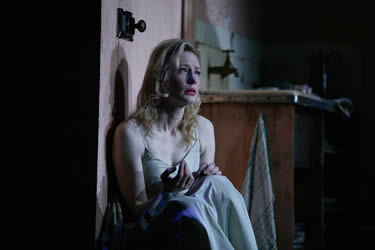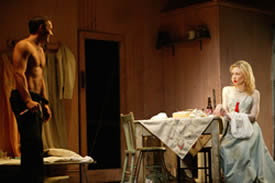
Notes on Blanchett's Blanche
By Jonathan Kalb
A Streetcar Named Desire
By Tennessee Williams
BAM Harvey Theater
651 Fulton St., Brooklyn
Box office: (718) 636-4100
Cate Blanchett has not been short of accolades
for her performance as Blanche Dubois in the Sydney Theatre Company
production of A Streetcar Named Desire, directed by Liv
Ullmann and now visiting BAM. The praise has been profuse and
prolonged--deservedly so, as this is surely one of this astonishing
actress' most accomplished and difficult performances. I see no
reason to add to the general encomium, but I would like to offer
a few specific observations about it. Once in a great while, a
performer's work is so original and luminous that it actually
alters our understanding of a famous and beloved play. Here are
four thoughts about Blanchett's achievement.
1. In all previous productions of Streetcar
I'm aware of, Blanche's effete southern-belle act was for the
most part understandable. That is to say, it was pretentious,
to be sure, but also plausible as a species of southern eccentricity--amusing
to others in the play, even persuasive at times, which meant that
one could believe that Blanche might eventually find sanctuary
in Williams's "raffish," tolerant and bluesy New Orleans. No such
possibility exists in Ullmann's production. Her New Orleans is
a bleak, claustrophobic place, a visually flattened sanctum for
blunted sensibilities, where Blanche's belle act has no social
traction whatever. No one believes it from the start, so she is
left looking all the more hopelessly adrift in a remarkably ugly
world. I strongly suspect that this uniquely unsentimental view
came easier to a Norwegian director and Australian actress than
it would to Americans brought up to romanticize everything about
the Big Easy.
2. In all previous productions of Streetcar
I'm aware of, the action as a whole was treated as a quasi-Darwinian
struggle for survival between two opposing natures, a quietly
epic showdown between rough and crude Stanley and refined and
delicate Blanche that ended in a sort of sexual death-clutch.
This is the legacy of Marlon Brando, who twisted Tennessee Williams's
intentions by stealing the limelight for Stanley when the play
was conceived as a portrait of Blanche, an exploration of her
uniquely fascinating and fantastic nature.  Blanchett
restores that original profile to the play, playing a character
whose complexity transcends description as a polar opposite of
anyone or anything. There is nothing weak or unduly subordinate
about Joel Edgerton's Stanley, mind you. Edgerton gives a marvelous
performance, but it's clear at all times that his character is
an instrument of the killing environment, not a co-equal antagonist
to Blanche. This is her story, just as exclusively as
if Williams had written it as an Expressionist drama with only
one real character.
Blanchett
restores that original profile to the play, playing a character
whose complexity transcends description as a polar opposite of
anyone or anything. There is nothing weak or unduly subordinate
about Joel Edgerton's Stanley, mind you. Edgerton gives a marvelous
performance, but it's clear at all times that his character is
an instrument of the killing environment, not a co-equal antagonist
to Blanche. This is her story, just as exclusively as
if Williams had written it as an Expressionist drama with only
one real character.
3. Notwithstanding her emotional isolation,
Blanchett's Blanche is as nuanced and specific as one could imagine--thoroughly
and heartbreakingly plausible. Unlike Vivien Leigh and countless
other actresses who have luxuriated in Blanche's glamour, Blanchett
is wholly plausible as a former prostitute. One has no trouble
believing she was truly degraded back in her home town, despite
her poise and elegance. She is a veritable skein of underconfidence,
never quite comfortable in her skin or her flashy clothes, and
she never flirts with the audience as if they were surrogates
for Mitch, as many other actresses do. Blanchett speaks and flirts
with an offhand self-consciousness suggesting that even she
thinks she's affected. Her haughty and brittle desperation reminds
me of Baudelaire's romantic pontifications: "Nothing that exists
satisfies me. Nature is ugly, and I prefer the monsters of my
fancy to what is positively trivial." There's an inner panic surrounding
her like a dirt cloud, which grows more and more visible as the
play goes on and she wears out her welcome at the Kowalskis'.
4. Blanchett restores terror to the play
by performing Blanche's final downfall as if it were a tragic
choice, not the conquest of a helpless victim. Her fall seems
inevitable yet chosen, like those Greek heroes Nietzsche describes
who yowl a defiant "yes" in the face of the power that crushes
them. Blanchett makes Blanche's destruction seem step-wise, a
sort of anti-pilgrim's progress, rather than a chaotic tumble.
She moves methodically from Blanche's flirtations with Mitch and
Stanley, to her ineffectual self-justifications and confessions
with Stella, Mitch and Stanley, to her final "date" with Stanley.
Eccentric and panicked as she is, this woman knows what she's
doing at all times, especially in the so-called "rape scene,"
which reads here, shockingly, as an act of courage. For Ullmann
and Blanchett, it seems, Blanche voluntarily surrenders to her
attack. Is that choice less touchy for a female director? Perhaps--it
certainly preserves a sense of agency for Blanche while she is
going under. In any case, her madness in the closing scene that
follows feels curiously self-preservative. In the end, Blanchett,
her face not quite a blank, wanders to an isolated corner of the
apron as a final spotlight on her fades to black. Madness for
her is clearly just another sanctuary to hole up in while the
world figures out how to accommodate its misfits. We can all hold
our breath for that.
------------------
Photos copyright: Lisa Tomasetti
